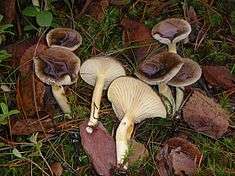Hygrophorus hypothejus
Hygrophorus hypothejus, commonly known as herald of the winter, is an edible species of fungus in the genus Hygrophorus native to Europe. It appears in late autumn in coniferous forests, often with the first frosts.
| Hygrophorus hypothejus | |
|---|---|
 | |
| Scientific classification | |
| Kingdom: | |
| Division: | |
| Class: | |
| Order: | |
| Family: | |
| Genus: | |
| Species: | H. hypothejus |
| Binomial name | |
| Hygrophorus hypothejus Fr. (Fr.), 1838 | |
| Synonyms[1] | |
|
Agaricus hypothejus Fr. 1821 | |
Taxonomy
Elias Magnus Fries described this species in 1821 as Agaricus hypothejus, before placing it in the genus Hygrophorus in 1838. Its species name is derived from the Ancient Greek words hypo and theios "sulphur yellow underneath". It has the common name of herald of the winter as it appears in autumn with the onset of the first overnight frosts.[2] Alternate names are late fall waxy cap in the United States,[3] and yellow-gilled waxcap.[4]
Description
The olive brown cap is 3–6 cm (1 1⁄8–2 3⁄8 in) across with a slimy surface,[2] and has a rolled margin when young and later flat and more funnel-shaped as it ages.[5] The yellow gills are decurrent, and the flesh is pale yellow, turning orange-red when bruised. The slender stipe is 4–7 cm (1 5⁄8–2 3⁄4 in) tall and 0.7–1.4 cm (1⁄4–1⁄2 in) wide.[6] The colour can become more intense with the onset of frosts.[3] The spore print is white and the oval spores measure 7–9 x 4–5 micrometres.[6]
It could be confused with the slimy spike cap (Gomphidius glutinosus), though the gills of the latter separate easily from the cap (unlike the herald of winter).[4]
Distribution and habitat
It grows in coniferous forests, appearing in October and November,[2] occasionally December. Though mushrooms may be abundant, they are often hard to spot among the pine needles.[5]
Edibility
European guidebooks list it as edible,[2][5] though not recommended on account of its sliminess.[6]
References
- "Fungorum synonymy: Hygrophorus hypothejus". Species Fungorum. CAB International. Retrieved 23 October 2015.
- Nilson S, Persson O. (1977). Fungi of Northern Europe 1: Larger Fungi (Excluding Gill-Fungi). Penguin. pp. 20–21. ISBN 0-14-063005-8.
- Roody WC. Mushrooms of West Virginia and the Central Appalachians. University Press of Kentucky. pp. 141–42. ISBN 9780813128139.
- Lamaison J-L, Polese J-M. (2005). The Great Encyclopedia of Mushrooms. Cologne, Germany: Könemann. p. 34. ISBN 978-3-8331-1239-3.
- Haas H. (1969). The Young Specialist Looks at Fungi. London, UK: Burke. p. 62. ISBN 978-0-222-79409-3.
- Phillips R. (2006). Mushrooms. London, UK: Pan MacMillan. p. 69. ISBN 978-0-330-44237-4.
External links
| Wikimedia Commons has media related to Hygrophorus hypothejus. |